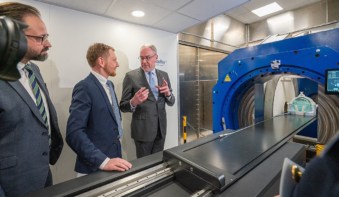A semiconductor laser that generates electromagnetic radiation with a frequency beyond the scope of current technology has been built by physicists in Italy and the UK. Constructed by Ruedeger Köhler and Alessandro Tredicucci of the Scuola Normale Superiore in Pisa and colleagues in Turin and Cambridge, the device that operates at 4.4 THz. Radiation of this frequency could be used in medical imaging, astronomy, chemical analysis and telecommunications (R Köhler et al 2002 Nature 417 156).
Semiconductor devices currently generate radiation at both ends of the electromagnetic spectrum. Oscillating circuits made up of high-speed transistors produce radiation for wireless communication at radiowave and microwave frequencies – 100 kHz and 3 GHz, respectively. At the other end of the spectrum, semiconductor lasers emit radiation at 300 THz or more, which can be used in optical fibre telecommunications.
Researchers have previously generated terahertz radiation using a laser built from lightly doped germanium. However, like other conventional semiconductor lasers, this device worked by recombining electrons in the conduction band and holes in the valence band. The frequency of the radiation was determined by the energy difference between these bands, which is an inherent property of the constituent materials.
The new laser on the other hand – known as a quantum cascade laser – was made from 1500 alternating layers of gallium arsenide and aluminium gallium arsenide, with each layer just a few nanometres thick. The quantization of electron motion perpendicular to the layers results in a series of discrete energy levels across groups of adjacent semiconductor layers known as stages. Since the spacing between energy levels depends on the thickness of the semiconductor layers, such a device could in principle emit radiation at arbitrarily long wavelengths.
By applying a potential difference across the thickness of the device, the electron energy drops in successive stages. So when an electron in the highest energy band drops to a lower energy level within that stage, it can be ‘recycled’ to the highest energy band of the stage immediately below. This process is repeated in successive stages, causing the electron to ‘cascade’ down the device in a series of steps, emitting many photons on its way.
Köhler and co-workers overcame several hurdles to create the laser. Using the quantum cascade effect, they were able to ensure that there were enough electrons in the highest energy levels for laser action. They also made a waveguide that can confine the laser’s long-wavelength radiation, and reduced optical losses arising from free electrons in the material.
Although their device only works at temperatures of a few kelvin, Köhler and co-workers believe that it could form the basis of commercial terahertz systems that would operate at higher temperatures. However, since the atmosphere absorbs radiation above 1 THz, such systems would have to operate at lower frequencies to be useful in telecommunications.



